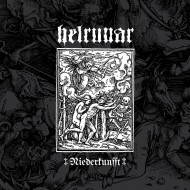 Helrunar have always stood out from the black metal crowd with their unique atmosphere and Germanic vibe. Rather than relying on the rapid fire blasts and tremolo riffs, the band has increasingly preferred to bludgeon with heavy riffs and hammer-like vocals in place of the usual razor-like treble that leaves your bass-bins starved of attention. After producing one of the more interesting pagan black metal albums the genre has managed to conjure up with Baldr ok Iss in 2007, the band have been on an ever more extravagant trend, first with the double album Sol and then with last year’s 15 minute-long corker on the mighty EP Fragments – a split with Helrunar main man Skald Draugir’s other band Árstíðir Lífsins and which I keep banging on about so, if you’ve not heard it, please do me a favour and grab a copy. But, clearly not one to slavishly follow the herd, or take the easy or predictable option, Helrunar is shifting again. Okay, this is a broad piece of work. But, rather than exploding in dark glory, Niederkunfft seems almost restrained. Thundering, dark, plate-mailed and growling atmosphere, yes, but at the same time brooding, rigid, almost austere.
Helrunar have always stood out from the black metal crowd with their unique atmosphere and Germanic vibe. Rather than relying on the rapid fire blasts and tremolo riffs, the band has increasingly preferred to bludgeon with heavy riffs and hammer-like vocals in place of the usual razor-like treble that leaves your bass-bins starved of attention. After producing one of the more interesting pagan black metal albums the genre has managed to conjure up with Baldr ok Iss in 2007, the band have been on an ever more extravagant trend, first with the double album Sol and then with last year’s 15 minute-long corker on the mighty EP Fragments – a split with Helrunar main man Skald Draugir’s other band Árstíðir Lífsins and which I keep banging on about so, if you’ve not heard it, please do me a favour and grab a copy. But, clearly not one to slavishly follow the herd, or take the easy or predictable option, Helrunar is shifting again. Okay, this is a broad piece of work. But, rather than exploding in dark glory, Niederkunfft seems almost restrained. Thundering, dark, plate-mailed and growling atmosphere, yes, but at the same time brooding, rigid, almost austere.
While this is undoubtedly the same self-confident Helrunar – with those stand-out anvil-fired vocals – the band has pretty much now shaken off all the folk elements completely. That’s obviously a good thing and was clearly happening over the last couple of releases. Lyrically, Niederkunfft is a potted European history lesson – focusing on the most horrible murderous aspects rather than the nice bits, in case you were wondering. Plagues, witch-burnings, the Devil himself walking among us, irrational fears of the world’s end, and the appallingly destructive Thirty Years’ War are the order of the day. If you want a visual artistic representation of the perspective on Niederkunfft, just whack seventeenth century French artist Jacques Callot’s name into Google. Les Grandes Misères de la Guerre illustrates the delights of the Thirty Years’ War with all its military order and murderous chaos. Whatever you think about the positive aspects of Western Europe from the fourteenth to the mid-seventeenth century, it was bleak, full of death, fear and paranoia and just generally shit, says Helrunar. The musical accompaniment to the lyrics is an ever more classic metal backdrop, shifting incrementally away from pure black metal – although those riffs are almost always tinged with jarring blackness. But Niederkunfft veers more wholeheartedly into a more traditional metal sound – more doomy territory and even dabbling with heavy, chugging thrash in parts.
Where Niederkunfft works best is when the earthshaking riffs and percussion lay bare the path towards the darker parts of Helrunar’s bleak vision. The vocals toll like church bells across war and plague-beleaguered cities and wailing guitars the lament of the poor Western European citizenry. Perhaps the slightly downbeat aspect of Niederkunfft is a fantastic representation to the downtrodden resignation of the times counterbalanced with the occasional black metal blast as rabid hysteria fires up. I can appreciate Helrunar’s artistic drive to do something a bit different – a musical reflection of 300 years of history is certainly that. But even so, it still feels a little less explorative than before – a little too emotionless despite the clear purpose and nice use of vocals, lead guitars and monastic chants. Niederkunfft, I would suggest, is not something that is going to flip Helrunar’s fortunes or gain them armies of new followers. But this is a great band and this is a solid piece of work even though I suspect it will confound and enthral in equally balanced measures.
(8/10 Reverend Darkstanley)

Leave a Reply